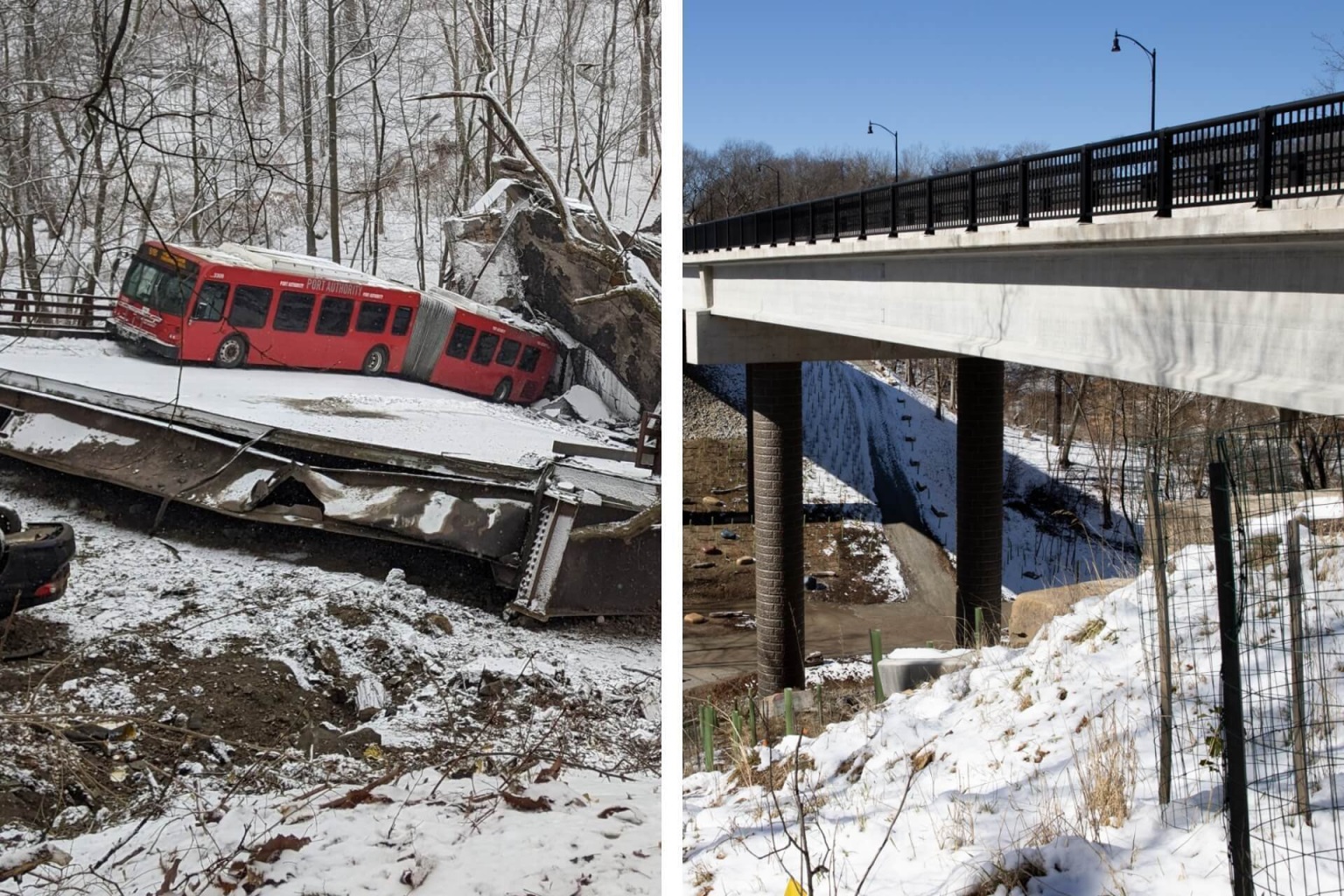Left: A bus rests on the collapsed Fern Hollow Bridge on Jan. 28, 2022. (Photo courtesy of Tracy Baton) Right: The rebuilt bridge in February 2024. (Photo by Pamela Smith/PublicSource)
Inspectors repeatedly flagged drainage issues and corrosion, and the city did little to respond, leading to the Jan. 2022 disaster.
Charlie Wolfson, PublicSource
Federal investigators reported that Pittsburgh’s Fern Hollow Bridge collapsed in 2022 because the city failed to take action on decades of warnings from state-picked inspectors — while inspectors themselves made critical errors that contributed to the disaster.
“Maintenance and repair recommendations were repeatedly made to the City of Pittsburgh, however they failed to act on them,” said Steve Prouty, a structural engineer and investigator-in-charge with the National Transportation Safety Board [NTSB], during a meeting to determine the causes of the collapse. “This led to progressive deterioration and structural failure of the bridge.”
The bridge collapsed early in the morning on Jan. 28, 2022. Multiple vehicles and a city bus fell with the 450-foot bridge into a Frick Park ravine, causing injuries but no fatalities. The collapse spurred the administration of Mayor Ed Gainey to emphasize bridge upkeep during his first year in office, but it also highlighted a staggering backlog of maintenance needs among the region’s hundreds of bridges.
Investigators found that clogged drains led to extensive corrosion to all four of the bridge’s legs, until the southwest leg gave out, triggering the full collapse.
A transcript of the investigators’ 2022 interview with state-contracted bridge inspector Tim Pintar showed that Pintar flagged drainage issues multiple times over the years.
“The number one problem was the clogged scuppers and downspouts on almost all their bridges,” Pintar told investigators in 2022. “And I tried to preach that the whole time, and nothing ever got done. I mean, just simply clean the stuff, you know?”
In a written response to NTSB questions in August 2022, city officials wrote that “The City did not have a preventative maintenance schedule to clean the storm water drainage system” and that the city never hired a contractor to clean the drains between January 2019 and the collapse. The city found no records of an earlier time in which it cleaned the storm drains.
“In our review of the reports, we found numerous inspection findings that were, with few exceptions, documented year after year,” Prouty said.
Investigators found that clogged drains led to extensive corrosion to all four of the bridge’s legs, until the southwest leg gave out, triggering the full collapse.
Gainey’s office did not immediately comment on the report.
NTSB staff also found that errors by inspectors and engineers contracted by the city contributed to the disaster.
[perfectpullquote align=”full” bordertop=”false” cite=”” link=”” color=”” class=”” size=””]NTSB officials commended Gainey and his staff, who entered city hall just 25 days before the bridge collapsed, for their efforts at improving bridge maintenance in the city. Gainey created a dedicated bridge unit within the city’s Department of Mobility and Infrastructure and signed a $1.5 million contract with engineering firm WSP USA to create a comprehensive plan, detailing each of the city’s bridges and outstanding needs. [/perfectpullquote]
Read entire article here
